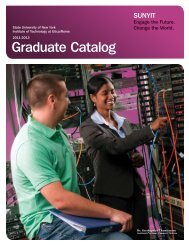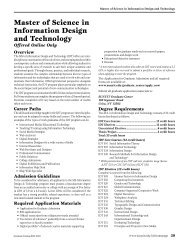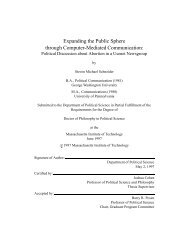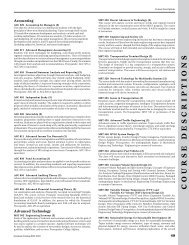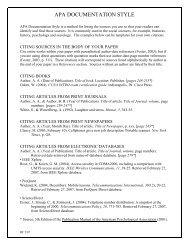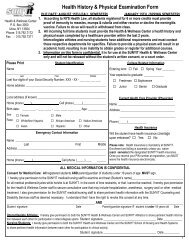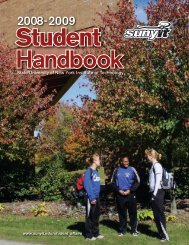undergraduate application and instructions - SUNY Institute of ...
undergraduate application and instructions - SUNY Institute of ...
undergraduate application and instructions - SUNY Institute of ...
Create successful ePaper yourself
Turn your PDF publications into a flip-book with our unique Google optimized e-Paper software.
EDUCATIONAL OPPORTUNITY<br />
PROGRAM (EOP)<br />
Note: You cannot apply for both the EOP <strong>and</strong><br />
Early Decision/Early Action programs.<br />
The State University <strong>of</strong> New York’s<br />
Educational Opportunity Program<br />
(EOP) provides academic support<br />
<strong>and</strong> financial aid to students who<br />
show promise for mastering collegelevel<br />
work, but who may otherwise<br />
not be admitted. Offered primarily<br />
to full-time students who are New<br />
York State residents, EOP accepts<br />
students who qualify, academically<br />
<strong>and</strong> financially, for the program.<br />
Note: You cannot apply for both<br />
the EOP <strong>and</strong> Early Decision/Early<br />
Action programs.<br />
Eligibility<br />
To be eligible for admission to EOP<br />
you must be:<br />
• A New York State resident for<br />
12 months prior to enrollment;<br />
• Ineligible for admission under<br />
traditional st<strong>and</strong>ards, but<br />
demonstrate potential for completing<br />
a college program; <strong>and</strong><br />
• In need <strong>of</strong> financial assistance<br />
within established income<br />
guidelines.<br />
In selecting students for the program,<br />
priority is given to applicants<br />
from historically disadvantaged<br />
backgrounds. If in the year prior<br />
to enrollment your family income<br />
falls within EOP guidelines due<br />
to unemployment, separation,<br />
divorce or death <strong>of</strong> a parent, etc.,<br />
you may still not qualify for EOP<br />
if you are not from an historically<br />
disadvantaged background.<br />
Required Records<br />
As part <strong>of</strong> the EOP admission<br />
process, your high school record<br />
<strong>and</strong> test scores (if needed) will be<br />
reviewed, as well as information<br />
about clubs, hobbies, jobs <strong>and</strong> any<br />
other experiences which made an<br />
impact on your education. This<br />
information will help college counselors<br />
evaluate your potential for<br />
success in a college program.<br />
Support Services<br />
When you enroll as an EOP s t u d e n t ,<br />
you receive special tutoring <strong>and</strong><br />
academic, career, <strong>and</strong> personal<br />
counseling. In addition, you<br />
receive financial aid to help with<br />
the cost <strong>of</strong> room, board, tuition,<br />
books <strong>and</strong> personal expenses.<br />
Fee Waiver<br />
The $40 <strong>application</strong> fee is waived<br />
for those eligible for admission to<br />
EOP. If you think you are eligible,<br />
check yes on Question 54. If you<br />
are found to be ineligible, you<br />
will be billed for the fee. Note:<br />
Applicants who are deemed ineligible<br />
for EOP may still qualify for<br />
admission <strong>and</strong> for financial aid<br />
as traditional c<strong>and</strong>idates.<br />
Contact the admissions or EOP<br />
<strong>of</strong>fice at your college choice before<br />
you apply. Note: The following<br />
campuses do not <strong>of</strong>fer EOP<br />
programs: Adirondack, Cayuga<br />
County, Clinton, Columbia-Greene,<br />
Herkimer County, Jefferson,<br />
Mohawk Valley, Nassau, Niagara<br />
County, Sullivan County <strong>and</strong><br />
Tompkins Cortl<strong>and</strong> Community<br />
Colleges.<br />
Transfers<br />
You are eligible for EOP as a<br />
transfer student provided you<br />
have been enrolled in EOP,<br />
College Discovery, HEOP (Higher<br />
Education Opportunity Program),<br />
SEEK (Search for Education,<br />
Elevation <strong>and</strong> Knowledge) or a<br />
similar program at your previous<br />
college. If your previous college<br />
did not have EOP or a similar<br />
program, you may be considered<br />
for transfer eligibility <strong>and</strong> should<br />
notify the college to which you<br />
are transferring.<br />
Income Guidelines<br />
The table below lists financial<br />
eligibility requirements for EOP<br />
admission during the 2003-2004<br />
academic year. To be economically<br />
disadvantaged, a student must<br />
belong to a household that is<br />
defined in Category A, B, C, or D<br />
or the exceptions noted.<br />
Household Categories<br />
A<br />
Supported by one individual who is<br />
part <strong>of</strong> a couple (i.e. parents <strong>of</strong><br />
student(s) or student <strong>and</strong> spouse)<br />
or by one or more individuals<br />
whose income is from Social<br />
Security or sources other than<br />
employment <strong>and</strong> which does not<br />
exceed the applicable amount<br />
under “Category A” below.<br />
B<br />
Supported by more than one<br />
worker whose income does not<br />
exceed the applicable amount<br />
under “Categories B <strong>and</strong> C” below.<br />
C<br />
Supported by either one worker<br />
(yourself) or a single parent worker<br />
whose total annual income does<br />
not exceed the applicable amount<br />
under “Categories B <strong>and</strong> C” below.<br />
EOP FINANCIAL ELIGIBILITY<br />
Household Size<br />
(including head<br />
<strong>of</strong> household)<br />
Total Annual Income<br />
In Previous Calendar Year*<br />
D<br />
Supported by one worker with two<br />
or more jobs in a two parent or<br />
student <strong>and</strong> spouse household<br />
whose total annual income does<br />
not exceed the applicable amount<br />
under “Category D” below.<br />
The income guidelines do not<br />
apply if:<br />
• You or your family receives payment<br />
from Temporary Assistance<br />
to Needy Families, Home Relief,<br />
Safety Net or Family Day Care<br />
through a New York State or<br />
County Department <strong>of</strong> Social<br />
Services, Office <strong>of</strong> Temporary<br />
<strong>and</strong> Disability Assistance, or<br />
Office <strong>of</strong> Children <strong>and</strong> Family<br />
Assistance;<br />
• You live with foster parents who<br />
do not provide support for college,<br />
<strong>and</strong> your natural parents<br />
provide no such support;<br />
• You are a ward <strong>of</strong> the state or<br />
county.<br />
Categories A Categories B & C Category D<br />
1 $13,290 NA NA<br />
2 18,400 $23,200 $20,200<br />
3 21,100 25,900 22,900<br />
4 26,200 31,000 28,000<br />
5 31,000 35,800 32,800<br />
6 36,350 41,150 38,150<br />
7 40,450** 45,250** 42,250**<br />
* Subject to approval by the New York State Board <strong>of</strong> Regents<br />
** Plus $4,100 for each additional family member<br />
A10




